what kind of bearing do i need to fix an rv furnace
People may enjoy RV travel because they tin explore the outdoors while maintaining the comforts of indoor living. Beyond the shelter an RV provides, appliances like a furnace make those outdoor explorations even more enjoyable. Just what do you exercise when you flip on the furnace, and there's no estrus? This is when RV furnace troubleshooting can save the day.
Tabular array of Contents
- How Does an RV Furnace Work?
- RV Furnace Diagnostic Lights and Codes for Troubleshooting
- Common RV Furnace Bug (and How to Troubleshoot)
- The Fan Runs, only At that place'due south No Rut
- How to Troubleshoot
- The Furnace Stops and Starts
- How to Troubleshoot
- Thermostat at Prepare Temperature, Merely Furnace Doesn't Shut Off
- How to Troubleshoot
- Furnace Non Working on Battery (vs. Shore Power)
- How to Troubleshoot
- Weak Air Period Through Vents
- How to Troubleshoot
- Furnace Fan Makes Loud Noises
- How to Troubleshoot
- The Fan Runs, only At that place'due south No Rut
- When Should Y'all Call a Repair Service?
- RV Furnace Troubleshooting:
How Does an RV Furnace Work?
The first step in troubleshooting an RV furnace is understanding its key operation.
Using your RV thermostat to turn on the furnace won't immediately accident warm air into your rig. This is past pattern. It'due south actually a safety measure to prevent noxious gases from entering your rig.
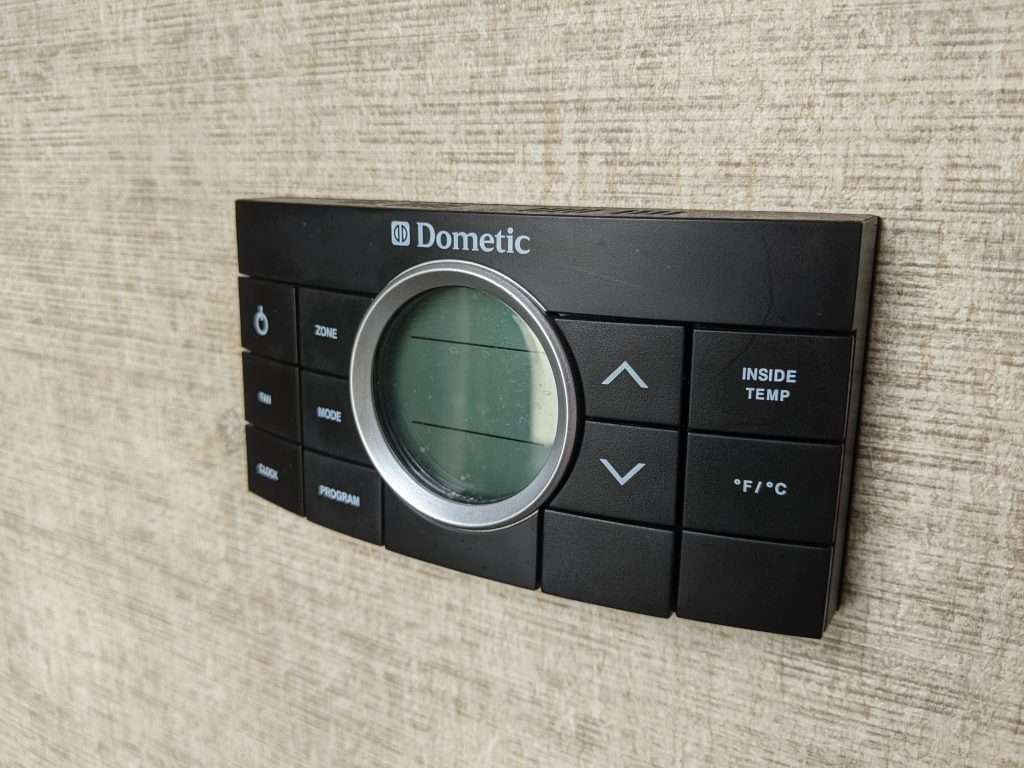
When turning on the thermostat, several things happen in rapid succession. Let's take information technology in tiresome motion:
First of all the furnace fan kicks on. The fan both blows air around inside the RV and sometimes forces air through the frazzle pipe. With the fan running it moves a "sheet switch" that signifies to the control board that there is airflow. It takes virtually 15 seconds or then for the command board to sense the airflow and start the ignitor process. It starts the ignitor just earlier the gas valve opens, allowing propane to menses into the combustion chamber.
The combustion chamber ignites the mixture of propane and oxygen. The ignited combustion bedroom heats the air as the estrus exchanger pulls in warm air and blows it through the ductwork.
When the air temperature reaches the thermostat setting, the system stops the heating process until the rig temperature drops. And the wheel starts once more.

➡ Looking for more information? Check out The Beginner's Guide to RV Furnaces for a total rundown on this essential winter camping appliance.
RV Furnace Diagnostic Lights and Codes for Troubleshooting
When it comes to diagnostic lights and codes on an RV furnace, it's more important to know what they are and how they work than to memorize specific numbers and messages.
Most newer furnaces have a diagnostic light on the side. The circuit board sends signals much like morse lawmaking; the number of blinks identifies the code. A chart somewhere on the furnace should tell you lot how to interpret the diagnostic lights.
If there's an issue with your furnace, the diagnostic light flashes. You then look upwardly the corresponding error code on the chart, which helps yous zero in on the exact issue.

Common RV Furnace Problems (and How to Troubleshoot)
Numerous bug can arise with an RV furnace. Below, nosotros list the about common RV furnace problems and how to troubleshoot them.
The Fan Runs, but There's No Heat
Normally, if the blower fan turns on only no heat comes out, you're dealing with a fuel, ignition or circuit board issue.
How to Troubleshoot
Fuel: First thing cheque your fuel supply. Make certain your propane is turned on and has pressure. You lot can bank check for pressure level by turning on your stove or another apparatus that uses propane. This is one of the most common causes for a furnace not to ignight.
Battery Voltage: The blower fan tin operate on low battery power, but the combustion chamber can't ignite if the voltage is likewise low for the fan to initiate the sheet switch. Typically, if your RV battery dips to 10.5 volts, the furnace won't operate. Recharging the battery is usually plenty to regain adequate voltage.
Pro Tip: Install an RV battery monitor in your camper to monitor your voltage and prevent discharging your battery too low.
Air blows cold but RV furnace doesn't low-cal
Airflow: Some other mutual problem is bereft airflow, unremarkably from a blockage in the air intake. Things that tin block your air intake include leaves, bugs, or other critters, nests, or debris. Cleaning out the intake is the quick fix to this event. Regularly cleaning the air intake is too a good addiction for regular furnace maintenance.
Sail Siwtch:A failed canvas or limit switch is another common culprit, as are corroded or loose fittings. Other issues include a failing gas valve, too much or likewise little pressure in the propane tank, or a failing ignition control circuit lath. Some of these are quick fixes, while others might crave professional repair.
Ignitor: Yous should be able to hear the furnace ignitor clicking abroad when attempting to ignite the fuel. If you practise non hear the clicking of the ignitor its possible there is a problem with the ignition circuit. Showtime, check the sail switch as mentioned above, and then have a look at the high voltage ignitor circuit. You tin can usually cheque the relay for the ignitor at the circuit board and run across if its supplying ability when it starts upward. If and then, but the ignitor is not firing, its possible you have a bad ignitor coil.
Did You Know? An RV propane regulator helps control your propane tank'southward pressure.
The Furnace Stops and Starts
If the furnace constantly stops and starts when it shouldn't, in that location are two mutual reasons: a faulty thermostat or an issue with the environs around your thermostat. If warm air hits the thermostat directly, the device will register the desired room temperature and shut off, fifty-fifty though it's just warm in that one spot.
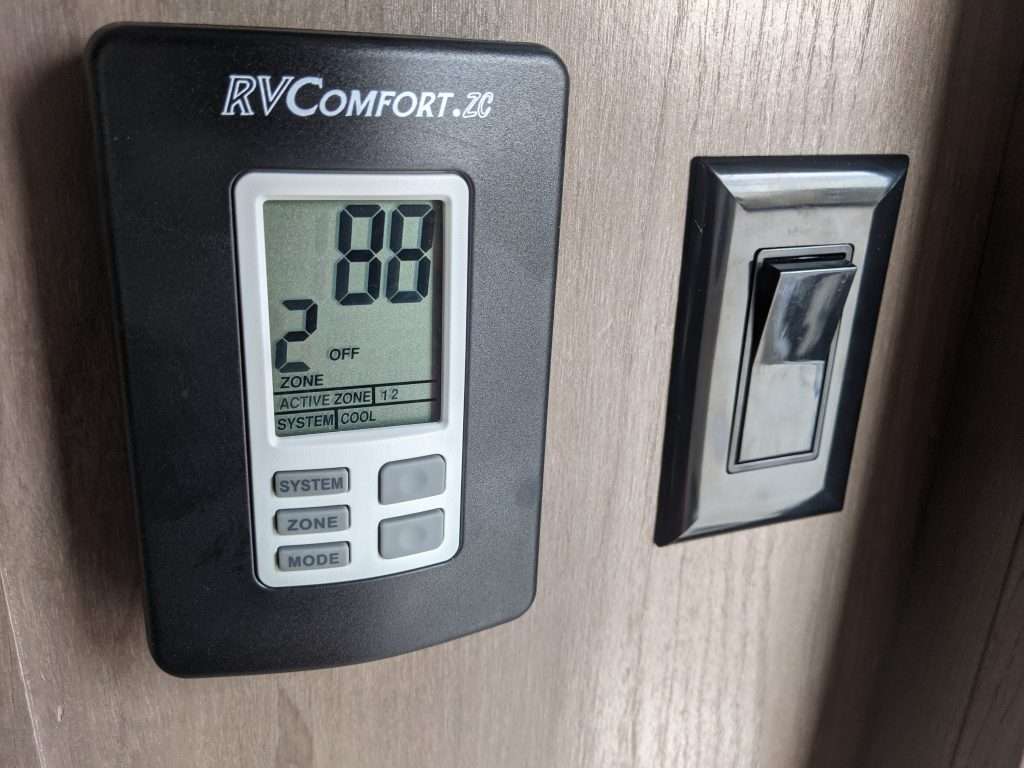
How to Troubleshoot
If the thermostat is faulty, just replace information technology. New devices are affordable, and as long as you supercede it with an identical model, you probably won't need a technician. When removing the sometime thermostat, accept pictures of all the connections so yous can reconnect the new wires in the aforementioned society.
A duct register pointing at the thermostat could cause it to close off prematurely. Redirecting the annals away from the thermostat should help.
You might see the same result if the thermostat is near a window or door with a leaky seal. Other areas of the business firm tin also run warm, and a thermostat placed also close could cause room temperature problems. For example, your fridge or oven can generate oestrus that affects your thermostat settings.

Pro Tip: Turn on your RV ceiling fan (or install a new one!) to help circulate warm air throughout your RV in the wintertime.
If possible, move your thermostat abroad from the warmer areas of your RV.
Thermostat at Prepare Temperature, But Furnace Doesn't Close Off
If the rig has reached the desired temperature but the furnace fails to shut off, the thermostat will request more heat from your furnace. This can create rather balmy conditions in your rig.
How to Troubleshoot
To troubleshoot this RV furnace problem, use a multimeter to check the voltage from the thermostat to the time delay switch. If voltage is present, the thermostat has failed. If there is no voltage, there's a short somewhere in the arrangement.
➡ We e'er proceed a multimeter in our RV took kit. Observe out what other tools we carry here: 36 Of import Tools You Demand In Your RV Tool Kit
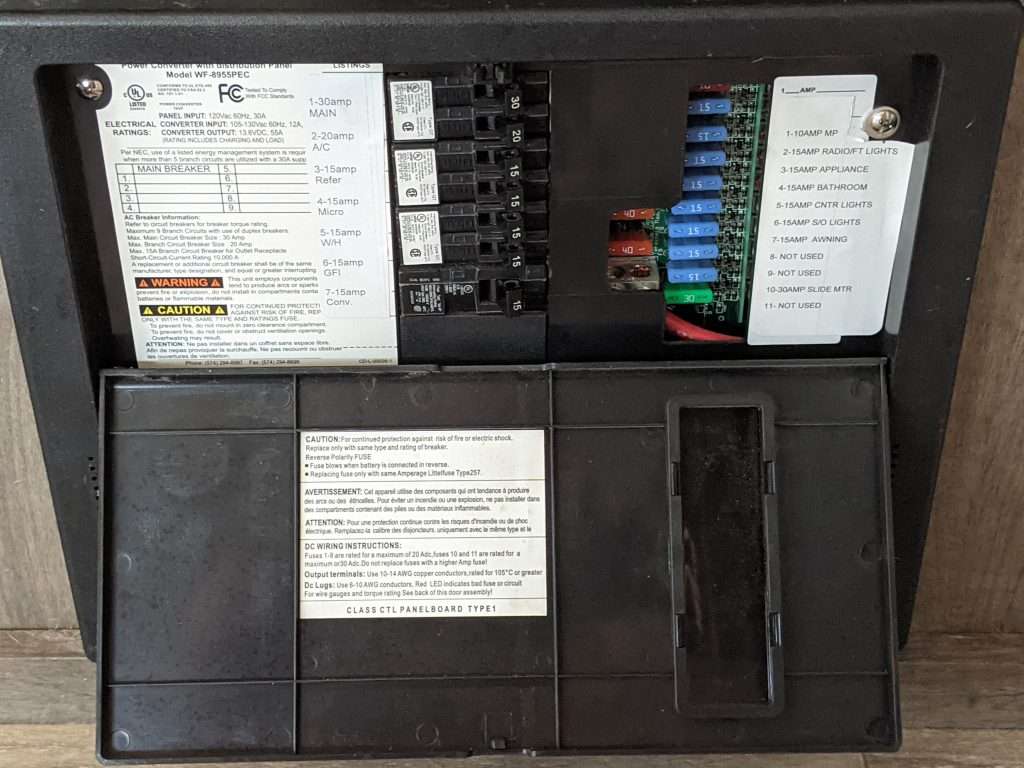
Y'all can check the fuse box in your RV. If the fuse was blown, merely replace it, and things should go dorsum to normal. If there's a brusque, you lot tin can endeavour to find it with your multimeter. Supplant whatsoever faulty fuses and splice shorted wires. Depending on the situation and your condolement level with wiring, you might demand professional help.
Notation that when the furnace reaches the desired temperature, the blower fan volition continue to operate for a curt time to bring the furnace temperature down. This is a safety factor that's part of normal operation.
More RV Repair and Maintenance Articles Yous'll Enjoy:
Furnace Not Working on Bombardment (vs. Shore Power)
An RV furnace should operate solely on 12-volt bombardment power. If it fails to work on battery ability just still operates when plugged into shore power or while a generator runs, the battery is either not charged, declining, or corroded at the connections.

➡ What's the difference betwixt 12-volt bombardment power and shore ability? Discover out here: How Are RVs Wired? Helpful RV Electric Basics for Beginners
How to Troubleshoot
Bank check to run across if the voltage on the battery is below 12 volts. You shouldn't discharge a pb-acid battery below 12 volts, every bit this causes bombardment impairment. Charge the battery to total capacity, and the furnace should be working again.
If your battery won't have a accuse or it drops in voltage immediately after charging, you probably take a faulty battery. Nearly auto supply stores will test your battery for free. If it fails the test, it's time for a new battery.
Pro Tip: Installing reliable lithium-ion firm batteries will decrease incidences of RV battery failure.
Do Lithium Batteries Work In Common cold Weather? Testing Lithium Vs Lead Acid in Freezing Temps
Cheque for battery corrosion at least one time a month. If you encounter corrosion on the posts, disconnect the cables–negative cable first–and then clean the posts and connectors. You lot tin purchase cleaners explicitly fabricated for battery terminals or brand your own.
A mixture of 1/four cup blistering soda and 1-1/2 cups water sprayed on the posts and connectors should break down the corrosion. Let it sit for a few minutes, then rinse with plainly water.
Weak Air Flow Through Vents
Weak airflow through vents is either caused by a blockage, holes, or loose fittings.
How to Troubleshoot
Checking the air intake for debris is a practiced place to start when troubleshooting this RV furnace upshot. If all is clear there, check the ends of the ducts to make certain they're snugly connected. Finally, follow along the duct, checking for holes or tears. If you observe any, use aluminum record to repair them.
Removing, Cleaning, and Inspecting Our RV Furnace
Note that many furnaces will not operate without the outside cover. So double-cheque the cover is in place any time you're checking for airflow or other operations.
Furnace Fan Makes Loud Noises
Fan noise is more often than not caused past a fan blade rubbing against the fan housing. Debris or even lint build-up could be the culprit. The fan motor could also make noise because of a loose or bad begetting.
How to Troubleshoot
First, check for any debris or lint in the fan housing; clean out anything you find. This is also a good time to put a few drops of light viscosity grease on the fan motor shaft correct next to the motor. Spin the fan blades by hand and mind. If the noise is gone, you've solved the problem.
Pro Tip: Consider investing in an RV vacuum to minimize dirt, dust, and debris in your rig.
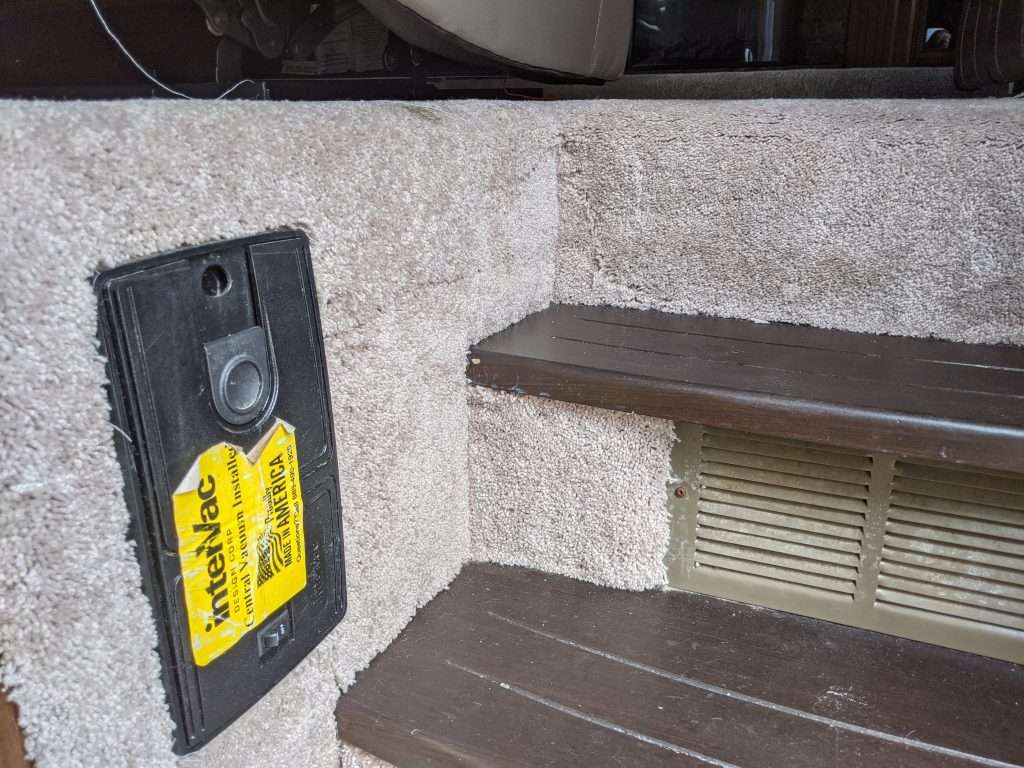
If in that location's still dissonance, check the fan housing to make sure it didn't rattle a spiral loose. If this is the instance, it may be as simple equally tightening the screw then that the housing no longer rubs on the fan blades.
Once you've tried the first couple steps, if the fan is still making a squealing or grinding racket, you likely have a loose or bad bearing. At this point, it may be time for a new fan motor.
When Should Yous Call a Repair Service?
Well-nigh of the time, a handy do-information technology-yourselfer can troubleshoot RV furnace problems and perform many repairs. But in that location are times when calling a professional is the all-time and safest option.
If you notice soot on the exhaust vent, it's time to phone call in the pros. Soot is an indication that there'due south a combustion problem, which can be extremely dangerous and cause a burn. It can also cause carbon monoxide–an odorless gas that's deadly if inhaled.

Regularly examination your carbon monoxide detectors and sentry for soot in the exhaust vent to forbid this. If y'all detect carbon monoxide or see soot on your external exhaust vent or elsewhere on your furnace, immediately shut it down and have a professional technician inspect it.
RV Furnace Troubleshooting:
The shelter of an RV and the added comfort of an RV furnace can brand your travels extremely enjoyable. It's much easier to explore the outdoors, particularly in the chillier months, when you know you tin can return to your rig and warm up in minutes.
However, anyone who has traveled for any amount of time in an RV knows that there are no guarantees that everything will go smoothly.
This is specially true for an appliance with several integrated parts, similar an RV furnace. Merely with the troubleshooting tips yous just learned, your RV furnace should operate for long periods with fewer instances of trouble.
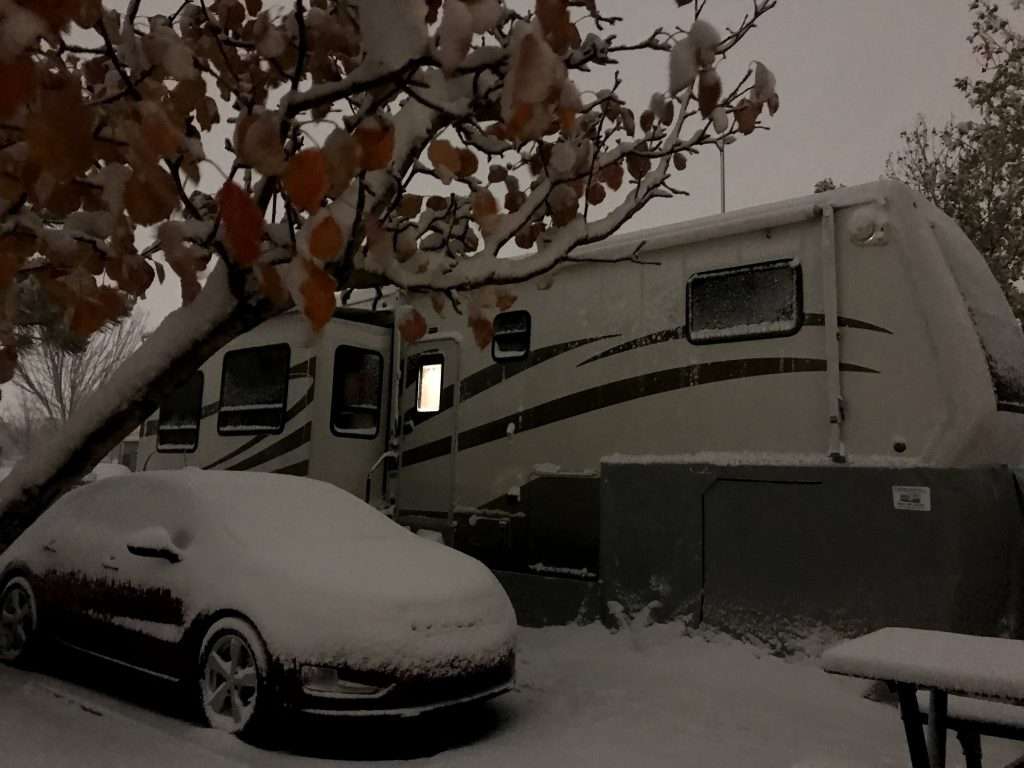
And fifty-fifty if yous do take problems, you lot soon will exist more capable of returning your RV furnace to full functionality and staving off a chilly nighttime in your rig.
Another appliance RVers commonly need to repair is the fridge. Acquire how to fix your RV refrigerator hither: RV Fridge Not Getting Common cold? Endeavour These Troubleshooting Tricks
Become A Mortons On The Motion Insider
Join 10,000+ other adventurers to receive educating, entertaining, and inspiring articles about RV Travel Destinations, RV Gear, and Off-Grid Living to bound-start your adventures today!
Read More From The Mortons:
Source: https://www.mortonsonthemove.com/rv-furnace-troubleshooting/
0 Response to "what kind of bearing do i need to fix an rv furnace"
Post a Comment